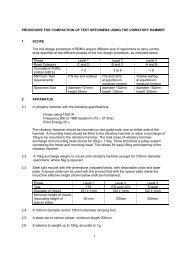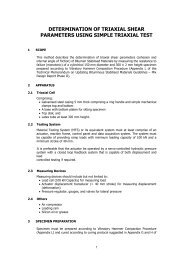Updating Bituminous Stabilized Materials Guidelines Mix Design Report Phase II
Moisture Sensitivity: Part II (Validation) - Asphalt Academy
Moisture Sensitivity: Part II (Validation) - Asphalt Academy
- No tags were found...
You also want an ePaper? Increase the reach of your titles
YUMPU automatically turns print PDFs into web optimized ePapers that Google loves.
findings of the moisture damage that observed through MIST conditioning. The setting for<br />
loading pulse duration and pressure of the MIST apparatus was influenced by the load duration<br />
and stresses of the wheel loads applied to the materials by the MMLS3 APT device. Therefore, a<br />
rational analysis should be possible.<br />
1.3 MMLS3 Accelerated Pavement Testing device<br />
The scaled testing of pavement structures and surfacing is becoming a standard in the industry.<br />
This is due to the advantages associated with evaluating and grading of the asphalt mixes<br />
proceeding to construction, (Walubita et al., 2002). The development of the Model Mobile Load<br />
Simulator Mk3 (MMLS3) contributes significantly to Accelerated Pavement Testing (APT)<br />
method. The performance prediction of a pavement tested for rutting, fatigue, and susceptibility<br />
to moisture damage is possible. All of these failure mechanisms can be evaluated in the field i.e.<br />
under full-scaled conditions or in a laboratory under controlled conditions. In the laboratory, all<br />
the variables that have an influence on the properties of the pavement materials can be<br />
controlled during MMLS3 testing. The need for the development of standardised test protocols<br />
for testing BSMs with the MMLS3 arises to make certain that the result that produced is<br />
reasonable and comparable. A standardised testing platform ensures uniformity in results and<br />
increases the confidence in the results.<br />
The MMLS3 consists of four axles and each axle has a 300mm diameter inflatable pneumatic<br />
wheel on it that circulates in a vertical closed loop. The wheels are supported in bogies that<br />
linked by a continuous chain. The wheels are powered by an electric motor that drives a drum,<br />
which draws the wheels over the testing bed. The MMLS3 can also apply lateral displacement<br />
(wander) of plus or minus 80mm around the central axis.<br />
The four wheels are loaded by means of a swing-arm and a spring. The four wheels exert the<br />
load on specimens underneath the MMLS3. The speed of the wheels controlled at maximum of<br />
2.5m/s, which is equal to 7200 wheel loads per hour. The testing conditions are controlled, and<br />
it is possibility to do tests at temperatures within a range of 0ºC to 60ºC. Figure J.1 provides an<br />
illustration of the MMLS3 test set-up.<br />
Figure J.1: MMLS3 in testing mode<br />
3












